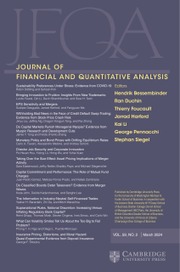No CrossRef data available.
Article contents
Discussion: Signaling, Information Content, and the Reluctance to Cut Dividends
Published online by Cambridge University Press: 06 April 2009
Extract
Avner Kalay makes a point that managerial reluctance to cut dividends is a necessary condition for the existence of a signaling equilibrium in which dividends are employed as a signaling device. He argues, however, that the available empirical evidence is unable to confirm the reluctance to cut dividends. In particular, the well-known Lintner's (1956) partial adjustment model, which is often cited in support of the reluctance to cut dividends, is empirically indistinguishable from an alternative model which is devoid of such a reluctance. Kalay then conducts an alternative test, but it too leads to an inconclusive result on the issue.
Information
- Type
- Signaling
- Information
- Journal of Financial and Quantitative Analysis , Volume 15 , Issue 4 , November 1980 , pp. 871 - 873
- Copyright
- Copyright © School of Business Administration, University of Washington 1980
References
REFERENCES
[1]Haugen, R., and Senbet, L.. “New Perspectives on Informational Asymmetry and Agency Relationships.” Journal of Financial and Quantitative Analysis (11 1979).CrossRefGoogle Scholar
[2]Kalay, A. “Signaling, Information Content, and the Reluctance to Cut Dividends.” Journal of Financial and Quantitative Analysis (11 1980)CrossRefGoogle Scholar
[3]Ross, S. “The Determination of Financial Structure: The Incentive Signaling Approach.” The Bell Journal of Economics (Spring 1977).CrossRefGoogle Scholar

